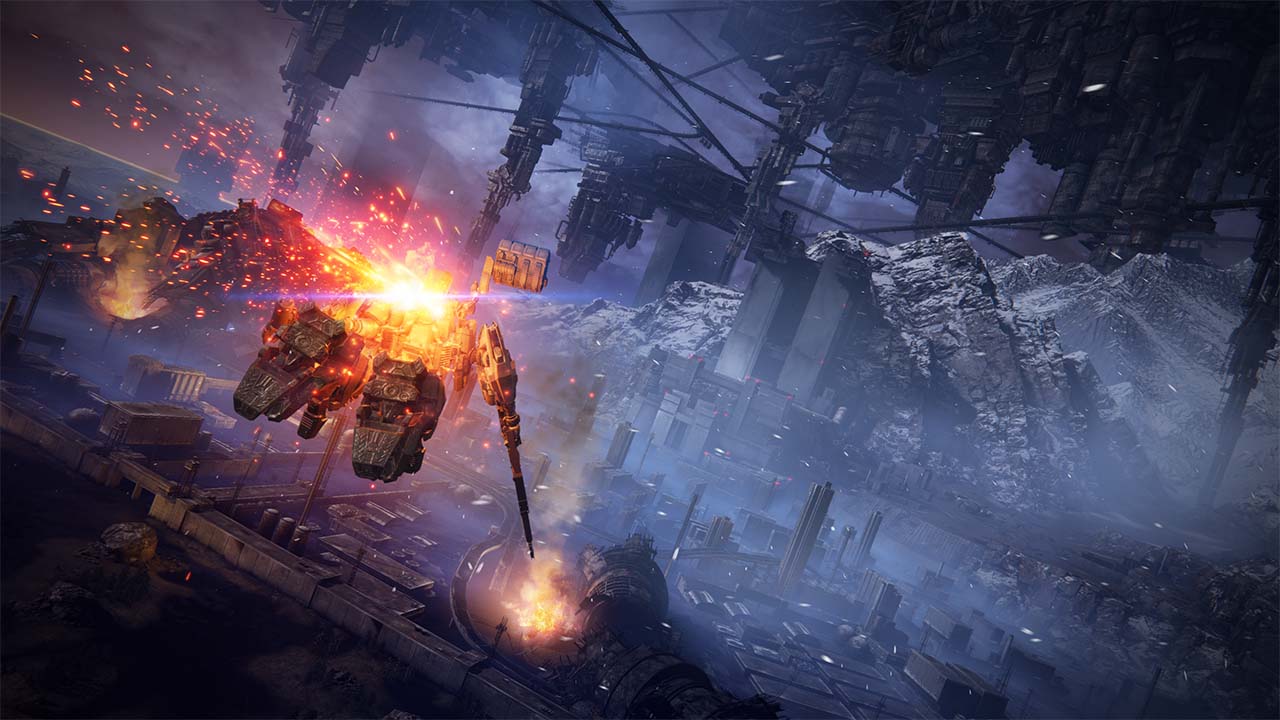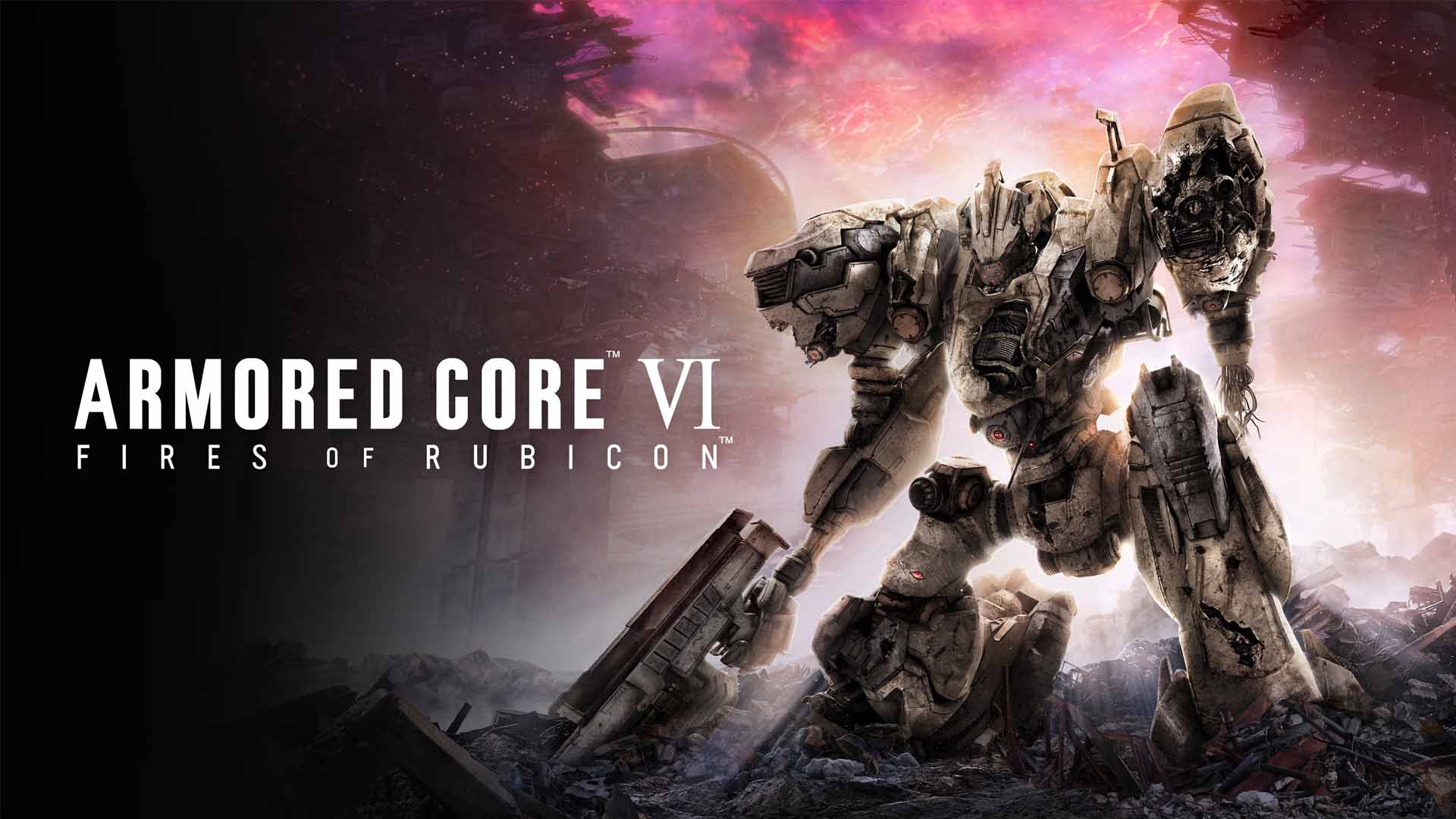Armored Core VI Fires of Rubicon is arguably the most fascinating game release of 2023. Elden Ring was a juggernaut; far outpacing even the most ambitious sales trajectories and cultural cache expectations, the open-world fantasy epic has sold over 20 million units since its launch in early 2022. FROMSOFTWARE’s previous best seller, Dark Souls III, took several years to hit half of what Elden Ring achieved in less than one. It is by all metrics the definitive stake in the market the company has been working toward with its Souls series for the better part of a decade. Its follow up? The sixth mainline entry in a cult favourite, notoriously unwieldy and inaccessible mech combat series. Of course.
We recently got a behind-the-scenes look at FROMSOFTWARE’s new beast, a gorgeously rendered and contemporary reboot of Armored Core that sees the developer pulling on both its Souls and obscure mech linage to craft something equally familiar and revitalised. Fires of Rubicon’s lead producer and FROMSOFTWARE veteran Yasunori Ogura led us through the core design ideas behind the game and portions of an early infiltration and assault mission.
Despite its label as the sixth game in the mainline canon, Ogura is clear that Fires of Rubicon will be a reboot of the franchise. Armored Core writ large encompasses over fifteen games and 26 years, snaking its continuity, lore, and mechanics between numbered sequels, spin-offs, and remasters. Taken broadly, Armored Core is a series about the collision between advanced sci-fi technology and extremely late-stage capitalism. You pilot a fully customisable mech, replete with a mind-numbing combination of weapons, systems, and body parts, all designed to help you navigate a dystopian world, make some cash from contractor gigs, and hopefully get out alive. The last time we saw an Armored Core title was 2013’s Armored Core V Verdict Day, which received middling sales and a lukewarm critical response. Now, with the eyes of the world on them, FROMSOFTWARE is readying up to try again.
Fires of Rubicon has seen the team make a fundamental shift in design philosophy, transplanting the best aspect of the Armored Core experience into the modern FROMSOFTWARE language. Internally this is understood to be a combination of reactive controls, dynamic world design, and house style challenging action. Ogura explained that these traits were effectively development pillars for the team, on top of which the refined tenets of Fires of Rubicon were designed. Those being a sense of massive world scale, customisation driven tactility in combat, and naturally, the satisfaction of having to overcome difficult encounters. This all seems to be in service of modern FROMSOFTWARE fans, onboarding players into a typically dense experience. Fires of Rubicon remains an Armored Core title though, down to its mission-based structure, open-zone environments, and single-player campaign, with multiplayer relegated to PVP matches.
Through a quick mission debrief, we learn that one of the game’s antagonistic forces, a group of arms dealers known as RaD, has taken control of a massive cargo launcher and it’s up to the player to wrestle it back. Small note, but the mission has been given to the player by the client Balam Industries, hinting that the freelance corporate military backbone of the games is very much intact. Fires of Rubicon’s world seems to be in the grips of a substance known as Coral, of which there are things called “convergences” and even Dosers, outlaws who are using it like a drug. With the goals set, the player is launched into the world and set loose to engage the objective how they see fit.

The world of Armored Core VI Fires of Rubicon will be imposing, complex, and compelling
It’s impossible to tell how this will all feel without going hands-on, especially considering the series’ penchant for atypical control schemes, but Fires of Rubicon looks fast, responsive, and smooth in moment-to-moment gameplay. Your mech is allowed total vertical freedom, burning through an energy meter in the centre of the HUD to fly and jump around the environment. The game is also adding an Assault Boost ability, which rapidly depletes energy but enables much faster movement, something the team says will be essential in both exploration and combat.
Engaging foes can be done in multiple ways depending on your mech assembly; target-seeking missiles, burst-fire kinetic weapons, energy shields, and close-range melee combat are all viable options for mob enemies. One particularly satisfying moment sees the pilot mech deliver a devastating kick to a smaller machine that careens off the edge of a platform and into oblivion. Your approach will also be dependent on the physical space around you, as open arenas full of environmental hazards seem just as common as tight, enclosed hallways that force a more defensive playstyle. Fires of Rubicon is also front lining its Impact and Stagger system, which sees players dealing damage to stronger foes and gradually filling a yellow Impact meter over their heads before forcing a Stagger phase during which direct damage can be done to the immobilised foe, akin to game director Masaru Yamamura’s previous title Sekiro: Shadows Die Twice.
Unlike Sekiro, death doesn’t seem to be too gruelling a fate in Fires of Rubicon. The level we saw featured several checkpoints, as well as distinct supply drop points along the path at which players can refill health kits and ammo. A flying cargo crate descends to deliver the goods, like a mobile bonfire. Better still, if you wind up falling in battle, you can adjust your rig from the continue screen, granting you access to entirely new builds mid-mission should you need to rework your weapons and form factor. While brief, the look we got at this customisation screen was tantalising; a crisp and easy to parse UI displaying countless combinations of technology, each component of the mech a distinct and customisable world on its own.

Boss encounters promise to be as challenging as FROMSOFTWARE’s best
The demo ended with a FROMSOFTWARE staple – the seemingly impossible boss fight. A towering monstrosity of industry, this combination of tank and small building wielded two massive, firey grinders for arms alongside an array of missiles and arranged assault weapons. Watching the now relatively small player mech dart around the boss was thrilling and it was clear that learning patterns and playing it smart would holdover from other Souls experiences in this whole new world.
This final encounter was to me emblematic of the broader experience being crafted with Fires of Rubicon, something fast and brutal and deeply engaging. It’s been ten years since the Armored Core franchise reared its metallic head but in that hibernation, the machine has been learning, and every success and lesson FROMSOFTWARE have experienced in the decade looks to have been uploaded directly into Fires of Rubicon.
Armored Core VI Fires of Rubicon launches August 25 on PS5, PS4, Xbox Series X|S, Xbox One, and PC.
One part pretentious academic and one part goofy dickhead, James is often found defending strange games and frowning at the popular ones, but he's happy to play just about everything in between. An unbridled love for FromSoftware's pantheon, a keen eye for vibes first experiences, and an insistence on the Oxford comma have marked his time in the industry.































